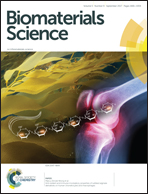Cationic folate-mediated liposomal delivery of bis-arylidene oxindole induces efficient melanoma tumor regression†
Abstract
The folate receptor (FR) is a well-validated and common target for cancer due to its high over-expression in many different cancer cells. Herein, we developed a new FR-targeting ligand (FA8) by conjugating folic acid and a cationic lipid. Owing to its favorable structural property FA8 as a ligand could be accommodated at an unusually higher molar ratio for a ligand-targeted liposome. We then encapsulated a drug-like molecule, bis-arylidene oxindole (NME2), in the targeted liposome. The resulting formulation induced potent caspase-8 up-regulation even in FR-moderately expressing melanoma cells. The NME2-associated non-targeted liposome (i.e., without FA8) or pristine NME2 could not up-regulate caspase-8. Caspase-8, an important apoptotic protein involved in the extrinsic pathway of apoptosis-signalling and inhibition of acquired drug resistance, was induced in cancer cells due to the combination treatment of liposomally associated FA8 and NME2 through the activation and subsequent cleavage of RIP-1. Consistently, in a melanoma tumor model too wherein FR is moderately expressed, significant tumour regression was obtained with this liposomal combination of FA8 and NME2. In conclusion, we demonstrate the development of a new FR-targeting ligand molecule whose higher level of inclusion (>10 mol%) in the liposomal formulation altered the mode of anticancer action of the encapsulated drug, thereby indicating a new therapeutic possibility involving FR targeted cancer treatment.



 Please wait while we load your content...
Please wait while we load your content...